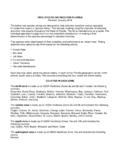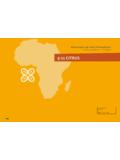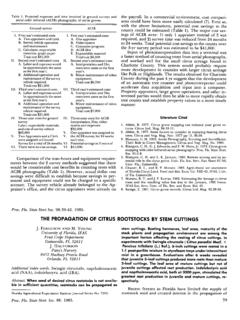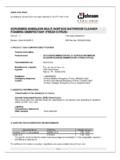Transcription of Physiology of citrus fruiting - SciELO
1 Braz. J. Plant Physiol., 19(4):333-362, 2007 REVIEWP hysiology of citrus fruitingDomingo J. Iglesias, Manuel Cerc s, Jos M. Colmenero-Flores, Miguel A. Naranjo, GabinoR os, Esther Carrera, Omar Ruiz-Rivero, Ignacio Lliso, Raphael Morillon1, Francisco R. Tadeoand Manuel Talon*Centro de Gen mica, Instituto Valenciano de Investigaciones Agrarias, Apdo. Oficial, 46113 Moncada, Valencia, de Coop ration Internationale en Recherche Agronomique pour le D velopement (CIRAD), SanGiuliano (Corse), F-20230, France. *Corresponding author: 31 October 2007; Accepted: 02 November 2007 citrus is the main fruit tree crop in the world and therefore has a tremendous economical, social and cultural impact in oursociety.
2 In recent years, our knowledge on plant reproductive biology has increased considerably mostly because of thework developed in model plants. However, the information generated in these species cannot always be applied tocitrus, predominantly because citrus is a perennial tree crop that exhibits a very peculiar and unusual reproductivebiology. Regulation of fruit growth and development in citrus is an intricate phenomenon depending upon many internaland external factors that may operate both sequentially and simultaneously. The elements and mechanisms wherebyendogenous and environmental stimuli affect fruit growth are being interpreted and this knowledge may help to providetools that allow optimizing production and fruit with enhanced nutritional value, the ultimate goal of the citrus article will review the progress that has taken place in the Physiology of citrus fruiting during recent years andpresent the current status of major research topics in this words: abiotic stresses, abscission, color break, flowering, fruit set, ripeningFisiologia da frutifica o em citrus .
3 citrus a principal fruteira no mundo, tendo, portanto, profundos impactosecon micos, sociais e culturais em nossa sociedade. Nos ltimos anos, o conhecimento sobre a biologia reprodutiva deplantas tem aumentado consideravelmente, principalmente em fun o de trabalhos desenvolvidos com , a informa o produzida nessas esp cies nem sempre pode ser aplicada a citrus , fundamentalmente porque citrus uma cultura arb rea perene com uma biologia reprodutiva muito peculiar e incomum. A regula o do crescimento edesenvolvimento do fruto em citrus um fen meno complexo e dependente de muitos fatores externos e internos quepodem operar tanto seq encialmente como simultaneamente.
4 Os elementos e mecanismos pelos quais est mulos ambientese end genos afetam o crescimento do fruto v m sendo interpretados, e esse conhecimento pode auxiliar a proverferramentas que permitiriam otimizar a produ o per se, al m da obten o de frutos com maior valor nutricional, o objetivoprec puo da Industria de citrus . Neste artigo, revisam-se os avan os que v m ocorrendo na fisiologia da frutifica ode citrus durante os ltimos anos; apresenta-se, tamb m, o status atual de pesquisas mais relevantes nessa : estresses abi ticos, flora o, matura o, vingamento de frutosINTRODUCTIONF ruit have been a matter of extensive research inrecent years because of their importance to agricultureand the human diet.
5 However, research on fleshy fruit hasfocused primarily on climacteric fruits such as tomatowhile other fruit models are not so well known. In thisrevision, we will review our understanding of citrus fruitdevelopment and will present it as a plausible model fortree and woody perennials. We will focus on thephysiology of citrus fruiting , an area that complementsthe information presented in two upcoming reviewsdealing with the generation of genomic tools andresources (Talon and Gmitter, 2008) and the progress inmolecular biology and genetics of development (Tadeo et334 Braz.)
6 J. Plant Physiol., 19(4):333-362, IGLESIAS et , 2008) in the genus citrus . The focus chosen for thisreview is on major physiological factors regulating fruitgrowth including flowering, hormones, carbohydratesand abiotic constrains. Also revised are majorbiochemical aspects of the ripening processes that maybe important for fruit quality. A central part of the reviewconcentrates on the hormonal and metabolic control offruit set and development and documents progress in theunderstanding of abscission and social relevance: citrus is the mosteconomically important fruit crop in the world, is grown indeveloped and developing countries and certainlyconstitutes one of the main sources of vitamin C.
7 There isalso an increasing demand of high quality fresh citrus driven by World Health Organization contain the largest number of carotenoids found inany fruit and an extensive array of secondary compoundswith pivotal nutritional properties such as vitamin E, pro-vitamin A, flavonoids, limonoids, polysaccharides,lignin, fiber, phenolic compounds, essential oils substances greatly contribute to the supply ofanticancer agents and other nutraceutical compoundswith anti-oxidant, inflammatory, cholesterol and allergicactivities, all of them essential to prevent cardiovascularand degenerative diseases, thrombosis, cancer,atherosclerosis and obesity.
8 In spite of these beneficialtraits there is still a major need to improve fruit quality tomeet current consumer s biology: From a scientific standpoint, citrus has proved to be valuable material for studyingmany biological questions because citrus combine anunusual mixture of reproductive characteristicsincluding, for example, non-climacteric development. Incontrast to climacteric fruits (reviewed in Giovannoni,2004), the mechanism of ripening in non-climacteric fruitsis basically unknown. citrus also exhibit a long juvenilityphase and nearly all important citrus species includingsweet oranges, mandarins, lemons and grapefruits showsome degree of apomixis.
9 Furthermore, many of them areparthenocarpic, sterile or self-incompatible and/ordevelop defective pollen (Baldwin, 1993; Davies andAlbrigo, 1994). In seeded citrus cultivars, fruitdevelopment is linked to the presence of seeds and,therefore, it depends upon pollination and usually takes place in the unopened oropening flower, often allowing pollination beforeanthesis. Cross-pollination occurs between plants ofdifferent genetic background by insect transport ofpollen. However, many current citrus cultivars are mostlyseedless varieties showing high parthenocarpy, in manyinstances due to gametic sterility.
10 Generative sterility canbe relative or absolute. Relative gametic sterility may bedue to self-incompatibility as in Clementine and to cross-incompatibility. On the other hand, absolute gameticsterility is associated with pollen and/or embryo-sacsterility. Some cultivars such as Washington Naveloranges and Satsuma mandarins have both, althougheven in these two varieties a few embryo sacs may oftenreach fruits are also classified as hesperidiums,berries of very special organization characterized by ajuicy pulp made of vesicles within segments. Thus, thecombination of these characteristics suggests that thestudy of citrus fruit growth may reveal original regulationmechanisms based on specific molecular differences and/or even novel genes (Forment et al.)
















